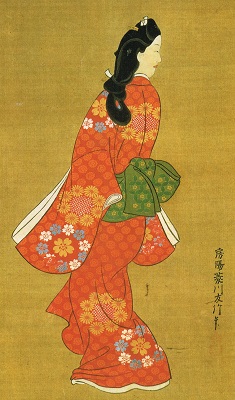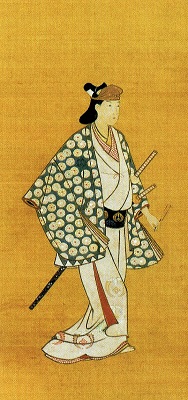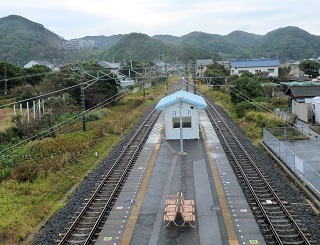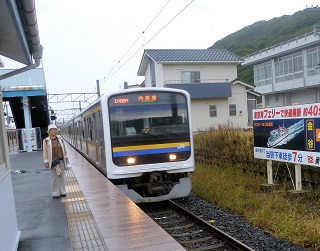I have lived in Urayasu City, Chiba Pref. for 30 years, good for seeing
the sight of Boso Peninsula.
Thanks to the convenience, I have made a short trip around there a number
of times. The travel essays and photo collections are in my homepage "Viva,
Seniors!".
I spent much time to try to inform foreigners of Nanki-Kumano District and my hometown there by means of translation of my essays related to them into English, and finally finished it last yearend.
While working it, such idea came out to me that the old climate and culture of Japan may impress foreigners the world over rather than our Japanese people.
If so, I thought, it might be worthwhile to introduce in English the various
parts of Japan remaining traditional cultures and local climates. The work
has been under way since this spring.
--------
Now Boso Peninsula, Chiba Pref.
I am especially interested in Southern Boso: Boso-Shirahama, Cape Nojimazaki, around Awa-Kominato, .......
Some TV program happened to make me notice that I had overlooked the important
scenic spot. It is Mt. Nokogiri with Nihonji Temple on it.
I remember a couple of my trips around there, but somehow, this spot is
not in my memory.
Emiko, my wife, agreed to my idea to visit Mt. Nokogiri, "2-day trip
from October 15".
Looked in a hotel on the internet, I reserved Kajiya Inn near the ropeway
to the top of Mt. Nokogiri and 5 minutes from Hamakanaya Station.
Every weather forcast says it will rain on the 15th partly because of the
aftermath of Typhoon 19. On the other hand it will be fine next day by
every forcast.
I decided to make a tour like this.
First day: strolling around Hota, the neighboring town.
Second day: whole day on Mt. Nokogiri, leaving the hotel early morning.
Mt. Nokogiri is in the area down south of Boso Peninsula.
As we have no car, another convenient way to get there is to take a train
at Shin-Urayasu on Keiyo Line for Soga, where to change to Uchibo Line
for Hota Station.
Our trip resulted in the following table.
| Wednesday, October 15 |
JR Shin-Urayasu Station 9:30
JR Uchibo-Hota Station 11:32 |
Lunch at "Banya"
Hishikawa Moronobu Memorial Hall |
Hota Station 15:30
Hamakanaya Station 15:34 |
| Stay: Kajiya Inn |
|
| Thursday, October 16 |
Mt. Nokogiri
Nihonji Temple |
Hamakanaya Station 16:00
Shin-Urayasu Station 18:50 |
|
- - - - - - - - - -
|
|
We arrived at Hota Station, after taking a series of train changes for
2 hours. The sky showed no sign of stopping rain.
I got a local map at the information desk in front of the station. According
to the staff, it takes about 20 minutes to the restaurant "Banya"
near Hishikawa Moronobu Memorial Hall.
It was a shame the next bus on a regular route would start more than 1
hour later. Emiko insisted to take a taxi but I talked to her finally into
walking, saying "Since we came all this way ...."
We walked in the real rain a little more than 20 minutes to see the fishing
port on the right, where a number of boats were anchored and on the beach.
"Banya" was over there.
Lunch at "Banya"
This restaurant, run directly by Hota Fisheries Cooperative, serves the
ingredients caught early in the morning in the fixed shore nets.
Emiko had dropped in here in spring several years ago, when she strolled
on the daffodil road with her middle school classmates. She says they had
to take a lunch at the temporary hall because the main hall was too full
then.
Banya is busy today too, in spite of a weekday and a bad weather. Truly
without a temporary hall, though.
The dishes were not expensive nor cheap. Set-meals, big bowls, noodles,
..... So many different dishes that it took us long to decide.
Finally we happened to order the same dish "Fisherman's regular big
bowl of rice topped by various raw fishes". Both of us left some shamefully.
Hishikawa Moronobu Memorial Hall
This memorial hall was within a stone's throw from Banya. The statue of
"A Beauty Looking Back" and the bell in the hut donated by Moronobu
welcomed us in front of the hall.
The inside is empty with a relaxing atmosphere. This hall, run by the town
of Kyonan, was opened in 1985.
We have nothing other to do from now. So, we decided to take time here.
But as the gallery was only for the works of Hishikawa Moronobu, it was
limited to a few displays. It seemed difficult to take up much of our time.
Whether to compensate for the weak point or not, the calligraphy exhibition
of Kaishin Makuta, a local calligrapher, was opened in another room. It
was still not good enough for us to kill time.
Anyway, the permanent exhibition rooms introduced Moronobu's everything
such as his personal history, the successful days in Edo, the influence
on the art world in Edo period and so on, through his works.
In addition, the history of ukiyo-e woodblock prints was exhibited so clearly
by illustration that I could take a look, nodding and thinking that I had
ever seen them somewhere else.
"Why is it no camera inside?"
I could not understand it, as I doubt no camera even in temples and shrines as far as they don't have any special reason.
During the travel around Benelux countries, there were no art museums to
prohibit taking any famous pictures. Rembrandt, Gogh, Vermeer, .....
I remember the guide's explanation at that time, saying "Thanks to
the acceptance of taking pictures with no flash, visitors have increased
tremendously. You can see every famous picture on the Internet nowadays,
anyway."
Emiko noticed they had a service of video projection and asked them to
do it for us. We could enjoy it for 40 minutes.
The following explanation is from the distributed pamphlet.
Hishikawa Moronobu (1618? - 1694) was a Japanese artist known for popularizing
the ukiyo-e genre of woodblock prints and paintings in the late 17th century.
He was the son of a well-respected dyer and a gold and silver-thread brocade
artisan in the village of Hodamura (presently Kyonan Town, Chiba Prefecture).
--------
Moronobu always wanted to paint genre pictures based on the common people
in Edo. And also in his original drawing, he painted the manners and customs
of kabuki and Yoshiwara red-light district tenderly and clearly. He pursued
women's beauty as shown in "A Beauty Looking Back" in his own
way, and in the result, he established the new style of art matched with
the then social conditions called "ukiyo" (transitory world).
Moronobu loved his hometown Boshu-Hota so much, so that his seal was Boyo or Bokoku (both related to his hometown) and he donated the temple bell to Betsugan-in Temple in Hota for a memorial service for his parents and relatives.
He died in 1694 at Edo. His ashes were buried in the graveyard of Betsugan-in Temple.
|
|
|
|
 |
|
 |
| A Beauty Looking Back |
|
A Young Actor of Kabuki |
I found, incidentally, some other information in the paper of Kyonan Town
as follows.
 Hota is a birthplace of Hishikawa Moronobu, the founder of ukiyo-e. Hota is a birthplace of Hishikawa Moronobu, the founder of ukiyo-e.
Hota beach appears in the famous ukiyo-e by Utagawa Hiroshige. Hota is
deeply related to ukiyo-e.
Also this town has relationship with poets and writers, like Kobayashi
Issa, haiku poet, Tokutomi Roka, novelist, Saijo Yaso, poet, and many others.
They left their haukus, poems and passages related to Hota.
Natsume Soseki, one of the most famous novelists, visited Hota beach to
swim in his high school days and after that wrote the travel essay "Bokusetsu
Note". Masaoka Shiki, his intimate friend, reading the essay, visited
Hota after 2 years.
Hota Beach, as the birthplace of swimming in the Boshu district, was the
most exciting summer resort around Kanto region.
Today it is secretly getting into the limelight as a filming location of
TV drama, CM, movies and still photographs.
|
It was about to stop raining when we got out of the memorial hall. I was
certain of the refreshing walk to Hota Station this time.
While walking, it became bright through the clouds, and patches of blue
sky appeared. The weather of tomorrow is guaranteed by the forecast, too.
 |
| Hota Station |
 |
| Hamakanaya Station |
Kajiya Inn was really near Hamakanaya Station.
After relaxed in the hot spring bath, a gorgeous dinner from 18:00.
A spiny lobster (ise-ebi) looking lifelike as a main dish, and a various
food on the table. They were surely matched with cold local sake and I
was most satisfied.
|